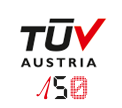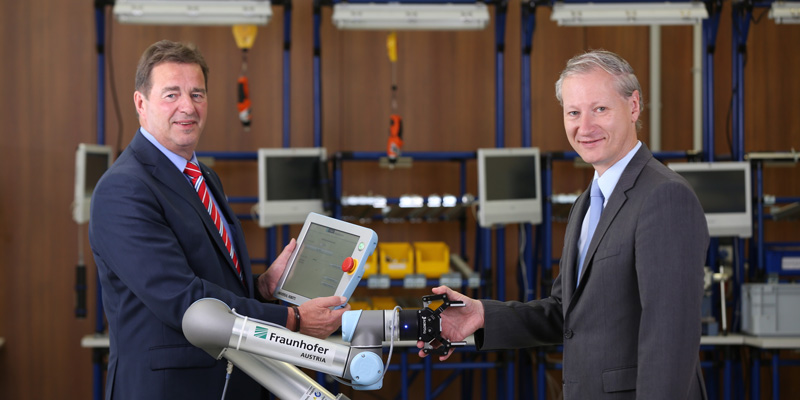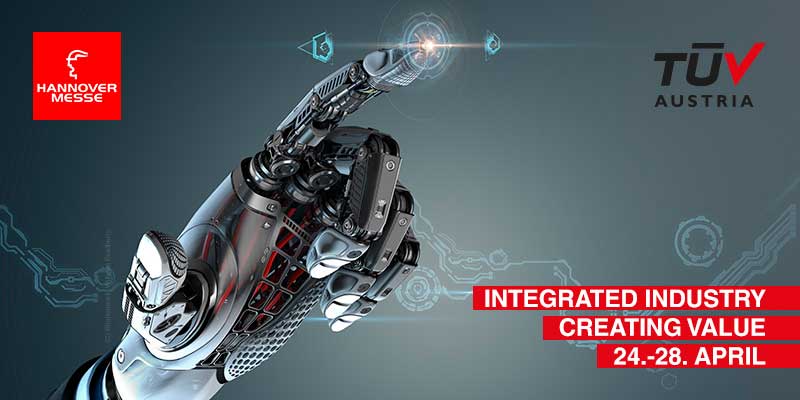TÜV AUSTRIA is involved in human-robot collaboration (HRC) research projects
- 04/17/2017
- Industry & Energy
- Created by Christiane Reitshammer
How can the safety of staff, machinery and the company be guaranteed?
“Ordinary” industrial robots are already standard use in the automotive and supply industries where the production of large quantities requires high precision. “An ‘ordinary’ industrial robot is completely remote from its surroundings and is ‘locked in’ by a fence”, Christoph Schwald, Corporate Innovation Manager at TÜV AUSTRIA, explains. “If due diligence is applied, the level of safety may be expected to be high.” HRC works very differently, however: “The robot interacts directly with a human, can pass workpieces or hold parts until they are processed by the worker.” According to Schwald, the use of such robots is especially relevant for the production of small batches with high variability and therefore “ideal for Industry 4.0 applications designed to provide customised products that may come in batch sizes of just one”. A further aspect concerns taking some of the strain off workers in terms of ergonomics, such as lifting heavy workpieces.
But wherein exactly lies the danger? Even though it is rather smaller than most assembly robots, an “unrestrained” robot may injure humans by moving a workpiece about. Within the meaning of Industry 4.0 and the “Internet of things”, however, data networking must also be taken into account and, consequently, the potential risk of cyberattacks. If controlled remotely with malicious intent, the robot could override the security settings and endanger humans, so systems must be checked with regard to such eventualities.
TÜV AUSTRIA collaborates with Fraunhofer Austria
Interdisciplinary collaboration between research institutions and businesses is virtually indispensable when it comes to Industry 4.0 solutions. This is why TÜV AUSTRIA has partnered up with Fraunhofer Austria Research to conduct an HRC research project: “The Industry 4.0 pilot plant at TU Wien is about setting up and operating a virtual demonstration plant, i.e. a learning, innovation and research plant, in the long term”, Christoph Schwald of TÜV AUSTRIA explains.
Products jointly developed by partners from the fields of industry and research are implemented in a realistic setting, then tested and modified until they are market-ready. “This enables us to pass on the latest findings of Industry 4.0 when put into practice in a vivid and tangible way – especially to SMEs”, the TÜV AUSTRIA manager continues. Risks associated with various applications are assessed and appropriate countermeasures derived from this. Wilfried Sihn, CEO of Fraunhofer Austria and Head of the Institute of Management Science at TU Wien, describes the collaboration as follows: “The most important synergies lie in the different perspectives of Fraunhofer Austria and TÜV AUSTRIA on technologies: productivity on the one hand, safety and security on the other. Both dimensions are critical to a company’s success, and in future we will be in the position to other integrated services in this area as a result of our collaboration.”
Collaboration with Joanneum Research
TÜV AUSTRIA has also teamed up with the Institute for Robotics and Mechatronics at Joanneum Research (Klagenfurt site). “Our collaboration with TÜV AUSTRIA enables us, an application-oriented research institute in the field of robotics and mechatronics, to bring the expertise we have gained from research and development closer to users”, Michael Hofbaur, Director of the institute explains. The institute can examine specific situations identified in a risk analysis by TÜV AUSTRIA – such as undesired human-robot collisions – for their respective hazard potential, using measurement technology.
HRC: Further development
Experts agree that robotics is the way forward. “Robotics is the bridge between the information technology innovations of Industry 4.0 and their actual application in manufacturing in the (near) future”, according to Hofbaur. “Automation is currently getting a considerable innovation boost owing to the new types and possibilities of modern robotics. In other words, without robotics the ambitious targets set by Industry 4.0 could only be realised to a very limited extent.”
Robotics allows branches of production that still rely heavily on manual labour even in Austria to combine the individual capabilities of machines and people in a joint process, Wilfried Sihn of Fraunhofer Austria remarks. The expert sees great potential for a broader range of uses, “provided that the safety of both employees and machinery is guaranteed.”
Human-robot-collaboration research tasks
Companies must determine the future division of labour between humans and robots and settle the issue of safety and security, both of which are research questions that Fraunhofer Austria is also currently working on, according to Sihn. The objective is to understand and utilise the peculiarities of robots used in flexible production, Hofbaur adds. These days, kinematic subtleties are also an issue in selecting a suitable robot: a robot may, for example, be able to solve a task in up to 16 different ways. Safety is a fundamental prerequisite in all areas. Hofbaur: “But we have also found that many of the now ‘unrestrained’ robotic systems are insufficiently prepared for the risks associated with the world of information technology, or, to use a buzzword, cyber security. There is a pressing need for research, development and explanatory information on the subject.”
The multitude of standards and guidelines in complex companies should be integrated into an all-encompassing safety and security policy, Sihn suggests. “The policy must be able to react to changing levels of risk – such as in the topical example of a higher risk exposure due to the increasing networking of production resources. External service providers with a high degree of interdisciplinary expertise in the fields of safety and security can give valuable advice and support in this regard”, Sihn states.
TÜV AUSTRIA Group: Industry 4.0 at the Hannover Messe / Fair April 24th-28th 2017


